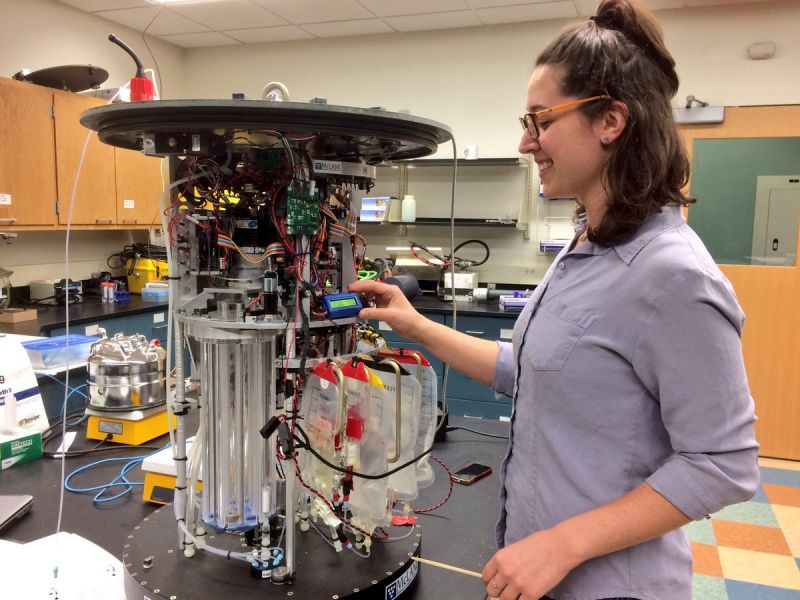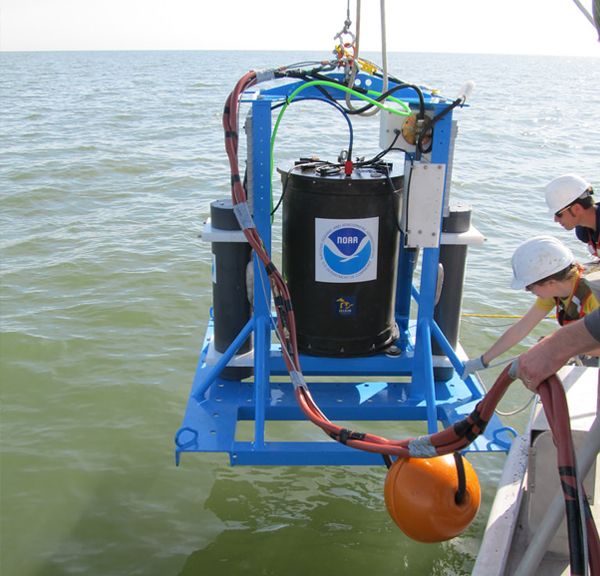Robotic Underwater Lab Tracking Toxicity of Lake Erie Algal Bloom
Published on by Water Network Research, Official research team of The Water Network in Technology
A new research tool to safeguard drinking water is now keeping a watchful eye on Lake Erie. A robotic lake-bottom laboratory is tracking the levels of dangerous toxins produced by cyanobacteria that bloom each summer in the lake's western basin.
The goal is to provide advance warning to municipal drinking water managers and thereby prevent a recurrence of the water crisis that left more than 400,000 Toledo-area residents without safe drinking water for about two days in early August 2014 due to high levels of microcystin toxins.
The purchase of the $375,000 device, which is known as an environmental sample processor or ESP, was a direct response to the Toledo event. It is positioned at a spot on the lake bottom where it can provide about one day's notice if highly toxic water appears to be headed toward the city's water intake.

Tests will be done every other day initially, then increased to once a day starting Aug. 1 to coincide with the expected peak in bloom toxicity. Test results are automatically emailed to the inboxes of researchers back in Ann Arbor.
"Our number one goal is to protect water intakes and to prevent public exposure to these toxins," said aquatic ecologist Tom Johengen, associate director of the Cooperative Institute for Great Lakes Research (CIGLR) at the University of Michigan. "If this device had been in place in the summer of 2014, it would have made a difference."
The project is a collaboration between CIGLR, the National Oceanic and Atmospheric Administration's Great Lakes Environmental Research Laboratory (GLERL) in Ann Arbor, NOAA's National Centers for Coastal Ocean Science and the Monterey Bay Aquarium Research Institute. The robotic lab, which goes by the name ESPniagara, was purchased with funds from the federal Great Lakes Restoration Initiative, which also helps pay the operating costs.
Two more ESPs will be deployed for testing in western Lake Erie next summer and should be in regular service in 2019, said Timothy Davis, a molecular ecologist at NOAA's Ann Arbor lab and leader of the GLERL-CIGLR harmful algal bloom monitoring team. Ultimately, toxicity data from the three autonomous labs will be incorporated into short-term algal bloom forecasts for the western Lake Erie basin.
The team's weekly sampling trips to Lake Erie will continue and are part of a comprehensive harmful algal bloom research program that also includes analysis of satellite imagery, genetic studies of cyanobacteria and the issuing of regular HABs bulletins to the public. A significant portion of the team's $2.5 million annual budget is provided by the Great Lakes Restoration Initiative.
 ESPniagara weighs more than 1,000 pounds and is lowered into the lake from the deck of a ship. It consists of a protective steel framework surrounding an analytical biochemistry lab inside a waterproof canister, along with a buoy that floats overhead.
ESPniagara weighs more than 1,000 pounds and is lowered into the lake from the deck of a ship. It consists of a protective steel framework surrounding an analytical biochemistry lab inside a waterproof canister, along with a buoy that floats overhead.
The steel framework is called the ESP lander, and it rests directly on the lake bottom. The buoy is tethered to the lab by a plastic hose and a data cable. The buoy collects water from the surface and pumps it down the hose to the lab, and it is also fitted with a cellular modem to transmit results back to Ann Arbor. Water samples are also collected 4 feet above the lake bottom, the same depth used by many municipal water intakes.
Inside the custom-built wet lab, cyanobacteria cells are filtered from the water samples, then the microcystin toxins are extracted from the cells. The liquid extract is then processed using an ELISA analytical biochemistry assay, a common biomedical test that uses antibodies and color change to identify substances. Once the test is complete, an onboard camera snaps a picture of the result and sends it back to Ann Arbor, where the brightness of the image is used to determine the amount of microcystin in the sample.
Source: Phys.org
Video and pictures source: University of Michigan
Attached link
http://www.youtube.com/embed/iNI-CzS6oM4Media
Taxonomy
- Technology
- Water Monitoring
- Environment
- Algae
- Water Monitoring
- Eutrophication
- Monitoring Technology